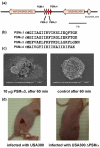The role of virulence determinants in community-associated MRSA pathogenesis
- PMID: 18585915
- PMCID: PMC2778837
- DOI: 10.1016/j.tim.2008.05.002
The role of virulence determinants in community-associated MRSA pathogenesis
Abstract
The recent emergence of community-associated methicillin-resistant Staphylococcus aureus (CA-MRSA) marked a quantum change in the biology and epidemiology of a major human pathogen. Various virulence determinants unique to CA-MRSA have been uncovered recently, which shed light on how these strains spread easily and sustainably among humans and frequently cause severe disease. The role of the Panton Valentine leukocidin (PVL) in CA-MRSA pathogenesis is a matter of much debate. Although epidemiological data have indicated a role for PVL in the CA-MRSA disease process, recent data from relevant animal models indicate that PVL does not impact virulence of prevalent CA-MRSA strains. Identifying specialized pathogenic traits of CA-MRSA remains a challenge that will yield new diagnostic tools and therapeutic targets for drug and vaccine development. Here, we discuss the roles of PVL, the arginine catabolic mobile element and phenol-soluble modulins in the pathogenesis of prevalent CA-MRSA strains.
Figures




References
-
- Herold BC, Immergluck LC, Maranan MC, et al. Community-acquired methicillin-resistant Staphylococcus aureus in children with no identified predisposing risk. Jama. 1998;279:593–8. - PubMed
-
- CDC Four pediatric deaths from community-acquired methicillin-resistant Staphylococcus aureus: Minnesota and North Dakota, 1997-1999. MMWR Morb Mortal Wkly rep. 1999;37:2658–2662. - PubMed
-
- Udo EE, Pearman JW, Grubb WB. Genetic analysis of community isolates of methicillin-resistant Staphylococcus aureus in Western Australia. J Hosp Infect. 1993;25:97–108. - PubMed
Publication types
MeSH terms
Substances
Grants and funding
LinkOut - more resources
Full Text Sources
Other Literature Sources
Medical

